How to Make a Split Tank: (with no previous experience*)
- Introduction
- Before You Start
- Buying Your Wood
- Buying Your Wire
- Making The Frame
- Attaching The Mesh
- Assembling Your Split Tank
- Using Your Split Tank
This article goes into great details about all the tips and tricks to making your Split Tank divide and Lid for those who are not regulars in the workshop.
*If you already have a bit of woodworking or practical knowledge – please skip to my How to Make a Split Tank – Short Version which just tells you the basics – assuming you already know your way around a workshop…
___________________________________________________________________
How to Make a Split Tank from Scratch.
Making a Split Tank can be really easy and doesn’t really require any great skills – although planning ahead and/or an extra pair of hands can make the whole thing go a lot more smoothly.
In most cases to create your Split Tank – you are only making the divide that runs through the middle of the tank. It needs to be quite sturdy – and sometimes double layered – but it is just basically a square or rectangle covered in mesh.
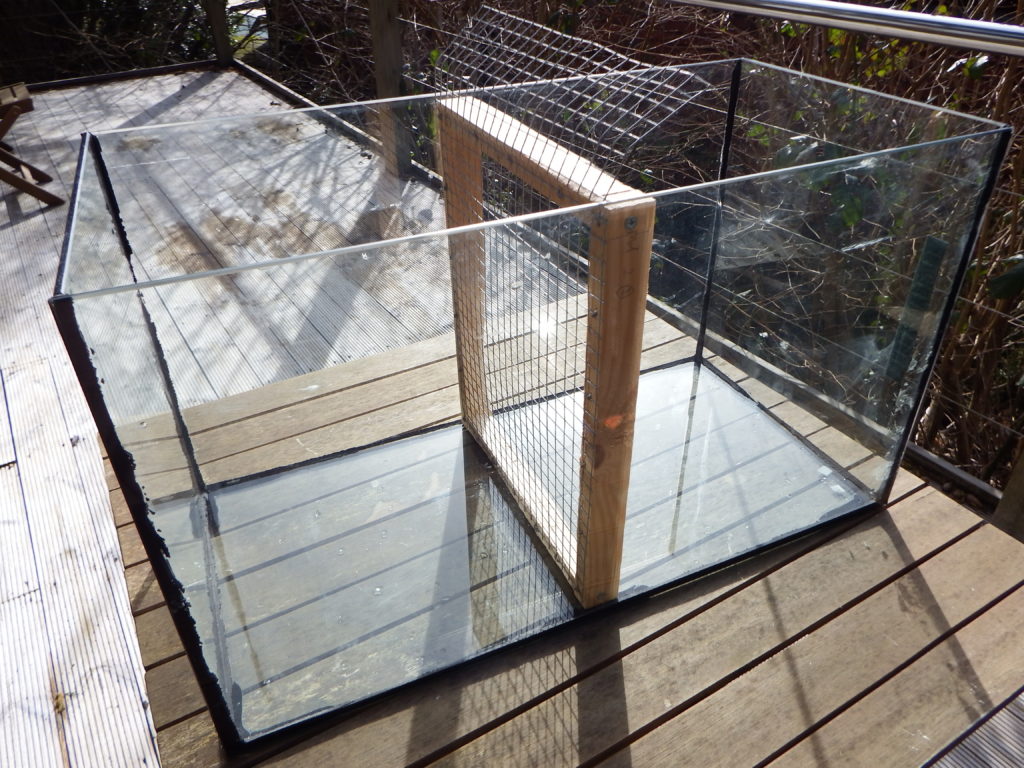
And there is a bit of maths and logic involved.
I made mine myself using very few tools, and they have lasted ages – and have been totally safe and secure for many, many Split Tank Introductions carried out over the years.
My Split Tanks were based on a plain shelf-less and lid-less 2 foot aquarium (c.60cm) – but this design is totally adaptable for any sized small shelf-less tank, or a larger tank that can be divided down to form a smaller tank size. Always use your own exact measurements as all tanks are slightly different. The measurements I use here are specific to my tank.
Also, depending on its current lid – you may be able to use it – or you may need to make your own lid. But don’t worry – you can make the new lid in the exact same way and of exactly the same stuff as your divide – so super easy either way.
What You Will Need
For the central divide of your tank you will need the following supplies and equipment:
- A tape measure
- A thick-leaded pencil
- A notebook or some paper
- A plain glass tank (with no top lip on the inside of it)
- Untreated kiln-dried pine wood strips
- 4 x 3cm screws (wide head)
- Approx 16 (fence) staples
- A section or roll of aviary mesh or very similar
- A pair of wire cutters
- A secure clamp
- A saw (either manual or electric)
- An electric drill with a variety of small bits
Before you do or buy anything though…
…you will need to know the internal size of your tank otherwise you won’t know how much wood or wire you need.
Standard tanks have three dimensions:
Length – usually taken as the longest external length of the tank
Height – usually measured from an external corner from bottom to top
Depth – the measurement of the outside of the tank from front to back
To work out the internal size though – you will be slicing through this tank (in your head) and taking a cross section.
These internal measurements will be fractionally different to the external measurements depending on the thickness of the glass – and this is very important.
Anyway, you will need only 2 measurements: The internal height and the internal width. So get your tape measure, pencil and paper ready…
Start by measuring the inside height from the base of the tank up the side and to the lip of the tank – this measurement should be the same wherever you take it around the tank. Write this down exactly in centimetres.
Do the same across the inside width of the tank – so measuring across the tank along its thinnest point – and write it down again in centimetres.
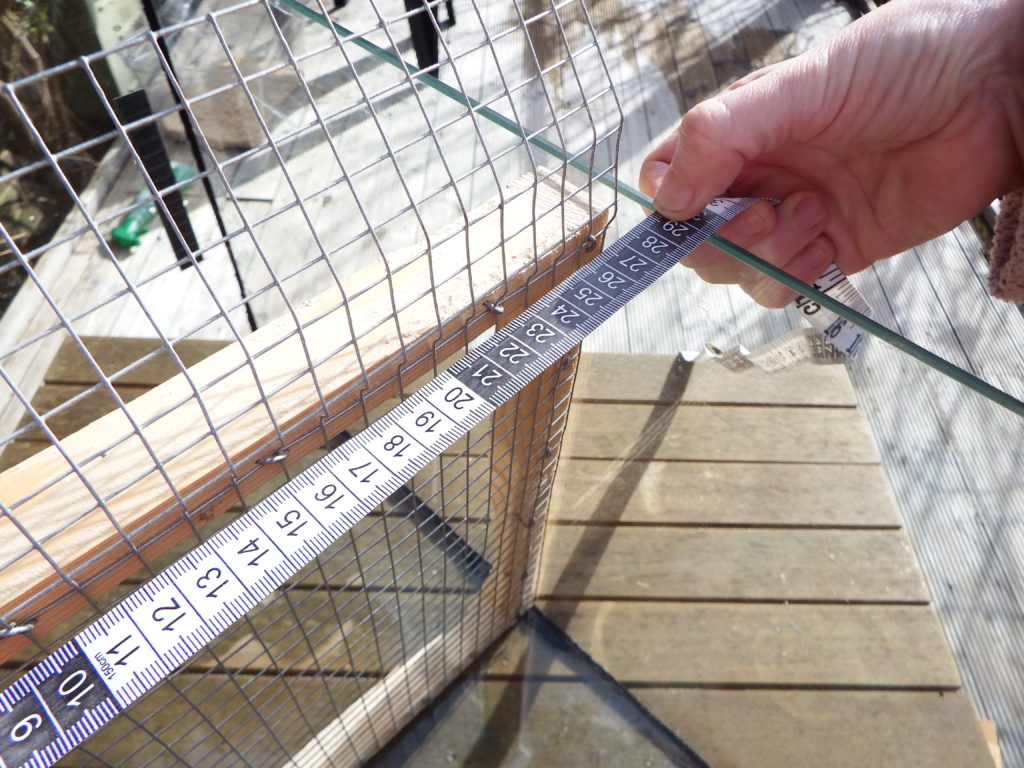
I am using centimetres here as the smallest measurements I am using are in cm and so the maths work out a lot easier.
You can use whichever measurements you want of course – as long as you are adding and subtracting at the right places!
Anyway, I know it might not sound like much difference from measuring the inside or the outside of the tank, but this solid wooden frame needs to fit snugly inside the tank – so these extra precise measurements will make sure it is a good fit.
If you are keeping the existing lid – it needs to sit flush with the top of your tank otherwise there will be a gap between the top of your divide and the underside of the lid when it is sitting in place on the tank. Even an inch is enough for your gerbils to climb through and injure themselves or each other – and this is why you can’t use a tank with an internal shelf – the shelf gets in the way of the divide.
So to accommodate an existing lid – measure up above the tank to the base of the lid – therefore closing off that gap – OR – plan to extend the wire above the frame by a good few inches, and it can then bend over gently to meet the underside of the lid keeping it secure (see image below).
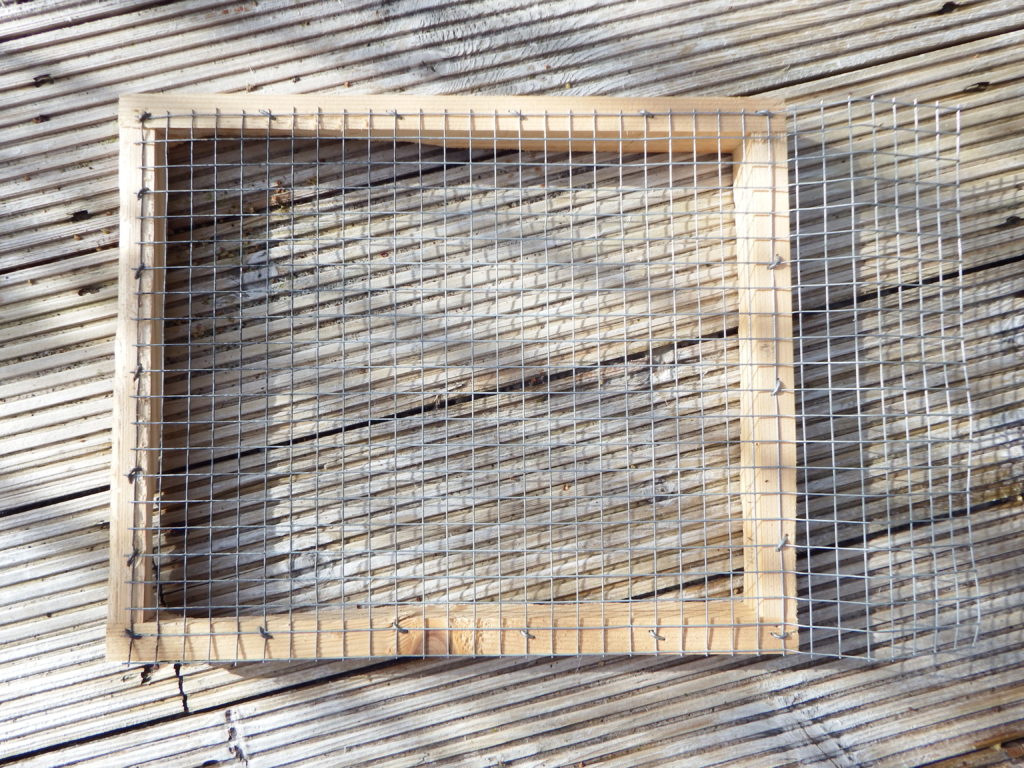
Now, back to the wood.
You have now measured your internal space – so we can figure out the length of wood we need. We just multiply each of those numbers by 2 and add them together – this will then tell you how long a piece of wood you need to make the frame.
So, for example; the inside of your tank measures:
38cm in height x 30cm in width
But as a frame has four sides – we need to simply double them: so 38 x 2 = 76 centimetres for height; and 30 x 2 = 60 centimetres for width – therefore your piece of wood needs to be 76 + 60 = 136 centimetres long.
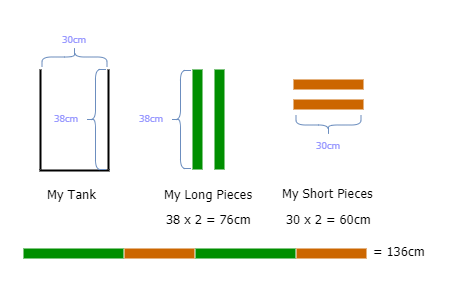
Hang On A Minute – Minor Adjustment Required
There is a little catch to this that you can either work out now or when you cut the wood – but basically – your measurement is going to be too long.
I know you measured it correctly – and you just followed the steps above to work it out – but you need to take into account the depth of the wood into the measurement.
You actually need the OUTSIDE of your frame to be the same size as the INSIDE of your tank – therefore you need to minus off the width of the wood from two of the sides.
This is the distance that the two pieces of wood are going to overlap.
If you don’t take it into account – the frames you make just won’t fit – see below:
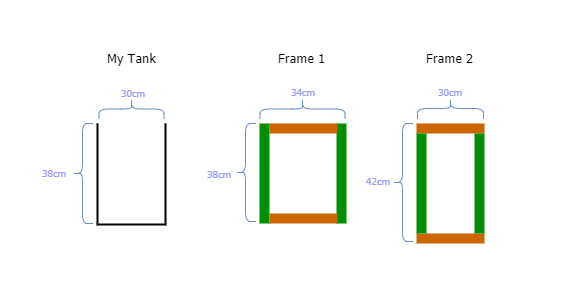
So for our example – let us stick with the same measurements as above and assume that the height of the sides will be the full length of the wood – so you still need two pieces of wood that are 38cm long. Nothing to change there.
However, as both these pieces of wood are 2cm wide as well (if you buy the same wood as suggested below) – those two pieces of wood are going to be a part of the overall width too.
You can’t ignore them – and added together are going to be 4cm.
Obviously then, you need to take your width measurement of 30cm and subtract this 4cm – leaving you 26cm only.
If you don’t subtract the width of these two sides, your divide will be too wide to fit inside your tank. You can’t squeeze 4cm of wood inside a glass tank if it doesn’t want to go in.
So we take the following steps to recalculate it:
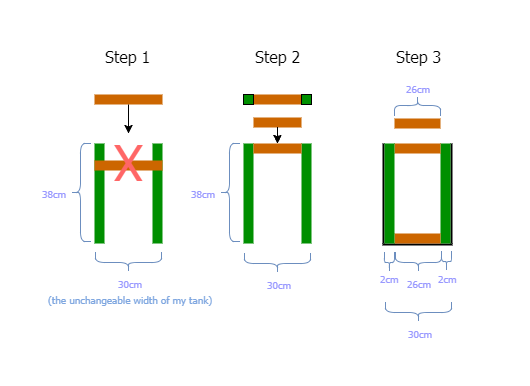 Use your tape measure to show how this all works out – and if you don’t take this 4cm off the width you will be able to see clearly that your divide will be too wide.
Use your tape measure to show how this all works out – and if you don’t take this 4cm off the width you will be able to see clearly that your divide will be too wide.
So in doing this – the actual overall length of wood you need is now only 38 x 2 = 76 centimetres for height (same); but now 26 x 2 = 52 centimetres for width (a full 8cm less) – therefore your piece of wood now only needs to be 76 + 52 = 128 centimetres long.

You could of course use the two pieces of the width at full length, and subtract the 4cm off the height (see above image for comparison of both) – it really doesn’t matter which – but knowing this before you buy your wood could make the difference between having to buy two bits of wood or just one.
I prefer to keep the longer sides of my frames at their full length and then put the shorter sides wedged within them – it is just how I like to remember it.
Visually this is easier as it will always create a pair of sides that are clearly longer than the other and so helping you in the workshop.
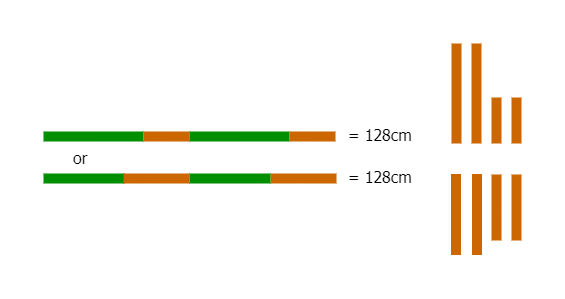 In addition then – if you are buying a different width wood for your frame – say 3cm x 3cm – you would need to take 6cm off each length.
In addition then – if you are buying a different width wood for your frame – say 3cm x 3cm – you would need to take 6cm off each length.
But remember, you only take this amount off two of the sides – not all four.
Buying Your Wood
Now you know how much you need – you need to find the right type.
Ideally, your wood would be a natural and untreated wood like pine – basically a slice of an actual tree.
You really want to avoid composite or glued together products as these are not really suitable for gerbil chewing and can contain all sorts of nasty chemicals.
If it is pine – it needs to be kiln-dried pine as this removes all the sap making it ‘safe’ – however, do still physically check for sap or other sticky or damaged parts before buying (as it will stick to your clothes too).
It ideally needs to be a ‘safe’ tree – so if your local place doesn’t sell kiln-dried pine, you need to check what other types they sell and find out if they are safe. I know your gerbils won’t be in this tank long – but they will still have plenty of time to chew it.
Whatever the wood – it needs to be brought in multiples of your required lengths and I always use pieces that are 2cm x 3cm in size. This is about the right size to make a divide that isn’t to obtrusive but is also quite sturdy – and is readily available in stores.
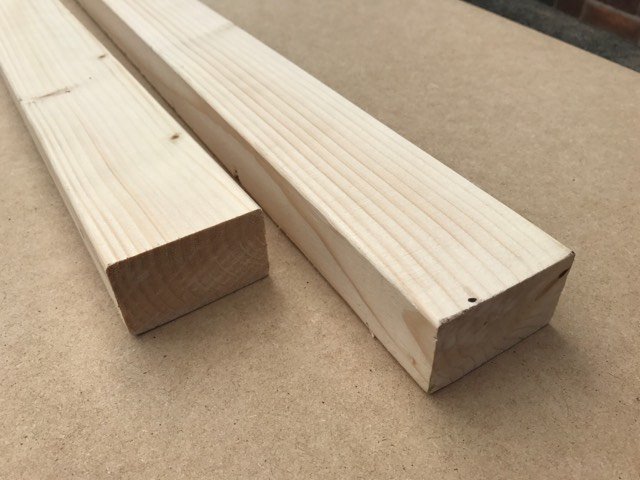
If you buy thicker pieces of wood for whatever reason – you will need to increase the length of your screws. Your screws should always be about 1cm longer than the shallower measurement of your wood (otherwise the screw won’t go through both pieces of wood or hold the two pieces together).
Once you have found out the length this wood is sold in – you can make sure you can still cut out all your whole pieces. If it is sold in shorter lengths than all your 4 sides added together, you need to buy two pieces.
If you are making more than one divide and/or you are making different lids – you may need to spend a bit of time working out how each piece of wood could be best used to buy the least amount of timber before buying it – as the sides for one piece could well tag onto the sides of another therefore wasting less wood in off-cuts.
And remember to work out your shorter sides here after subtracting your 4cm or 6cm – as this could make all the difference.
Draw out your shapes and cross off the pieces as you calculate them to make it easier to visualise if you need to – I know it can get quite confusing when making multiple frames.
Buying Your Wire
This should be easy as I have only ever found 2 styles of suitable wire for sale – so it could just be down to one or the other. One is a sheet, and the other is a roll.
I use smaller-sized aviary wire for mine (13mm) as this size grid size has been designed to keep rodents out of aviaries – perfect for keeping gerbils apart in my split tanks.
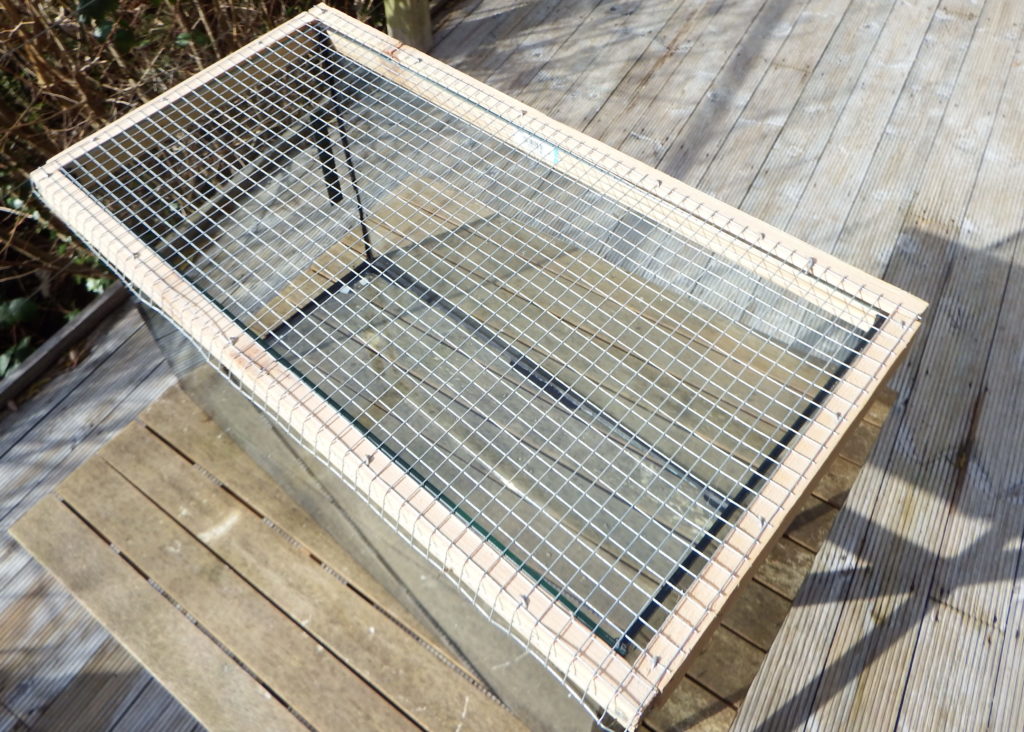
The larger version of this aviary wire (with 1 inch squares – 25.4mm) is too big for gerbils as they can get too much of their face and heads through it – possibly allowing enough of target for teeth on the other side.
If your required square or rectangle is smaller than the pre-made section – you are good to go – or twice the size if you are hoping to double-layer your divide. However, if you are taking this opportunity to make some lids for a few cheap tanks you picked up before – then go for the roll.
I don’t really like the idea of using anything less solid than this mesh for splits and lids and I know what a tough job they have to do – and chicken wire type wires are just too weak full stop.
All wire is spiky and sharp though – so do be careful when transporting it or cutting it.
Making Your Split Tank Divide
Finally, we are good to go. You have everything on the list ready and we have plenty of space for cutting and planning?
OK – first things first – mark out your wood.
You need to mark each piece of wood with the cutting points for your sides.
So, I get out my thick pencil and the sheet of paper with my measurements on it and start to mark out the sides of the frame onto the wood itself – one mark to identify which side of which frame it is and another mark to mark where to cut it.
Depending on how many frames you are making – call them:
Frame 1 – Side 1; and
Frame 1 – Side 2; for example.
You need to so this for sure if you are making more than one frame, as once you have all the small sections cut you won’t easily know which side goes with which lid or divide without measuring everything all over again.
I also shade in the sections of wood that I won’t be needing to use, so they don’t get in the way when they don’t need to – I know I can put them straight to one side.
I also try not to cut wood so that it has a bit knot at the end – as this is a weak point already. The last thing I want to be doing is putting a screw through it right there and breaking my wood. Simply adjust your lengths and cutting points to avoid these knots at the ends.
Anyway, double check all your marks before you cut anything – as remember – you need to reduce these lengths for your divide construction (to take off the widths of the parts of the frame themselves (see description above).
HOWEVER – if you are making a lid for a tank – you have to do the opposite.
I know right – how annoying!
This is because you are putting this frame outside of the tank. Not only will you have had to have measured the outside of the tank (rather than the inside) you then need to ADD ON the widths of the wood. So you leave the short sides at their original length (30cm), and make the long sides longer (38 + 4 = 42cm).
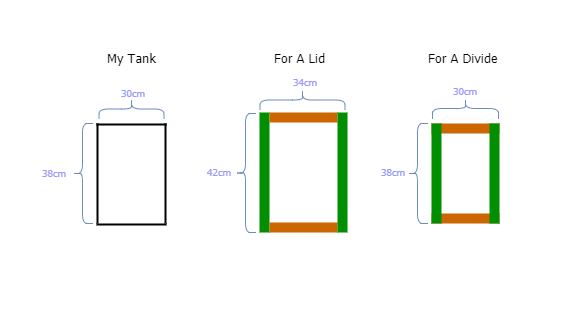
This way the inside edge of the lid will be a fraction bigger than the measured outside of the tank.
Whereas the divide needs to have it’s outside edge a fraction smaller than the measured inside of the tank.
I know it is all a bit of a fiddle – but you really will regret it if the lid is too small or the divide is too big. The lid being a bit too big or the divide a bit too small doesn’t matter so much – but it can’t be the other way around.
When made correctly – the two should sit together in a nest – see image below:
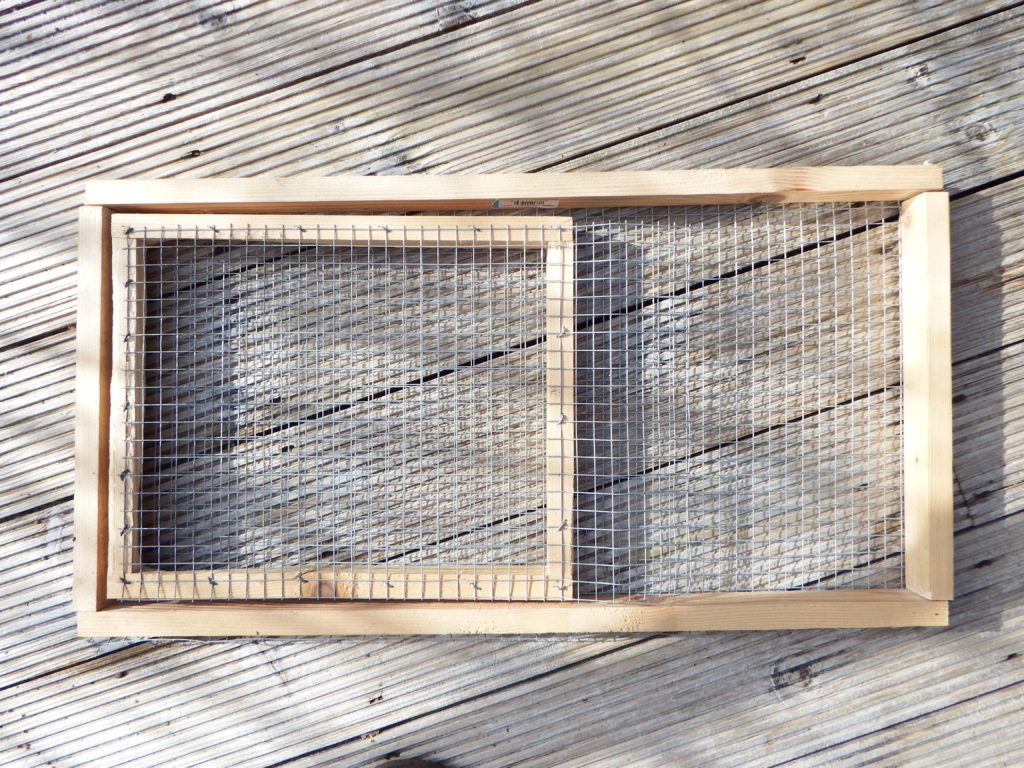
Making The Frame:
So, you have marked out your wood precisely, now you can cut it using your saw.
All the pieces are marked and labelled, so just cut everything out in one long session. Put all the labelled pieces on one side and put all spare pieces and cut-offs far away on the other.
Once you have finished, move all the labelled pieces onto the counter or floor and lay them out as though they are finished. Have the two two pairs of sides laid out as though they are already screwed together and then re-measure the outside of your divide to make sure it is the same as the inside of your split tank.
Do the same for the inside of any lids you are making – this way everything has been checked on last time before you make it.
Now you can’t just screw screws into wood without the risk of cracking your frame, so you need to countersink a slimmer hole in the wood where you want to put the screw.
Where you put these screws will determine the final size of your frame – if they are too near the edge – your frame will become slightly larger – you need to make sure your smaller side – when fixed in place – it flush with the outside – not sticking out.
You also need you pieces of wood facing the same way – and as you have added on only the 2cm extra for each piece of wood – make sure that is the way you face your wood. So, to make this work – you will be sinking these holes into the flatter faces of the longer sides (green) – as shown below.
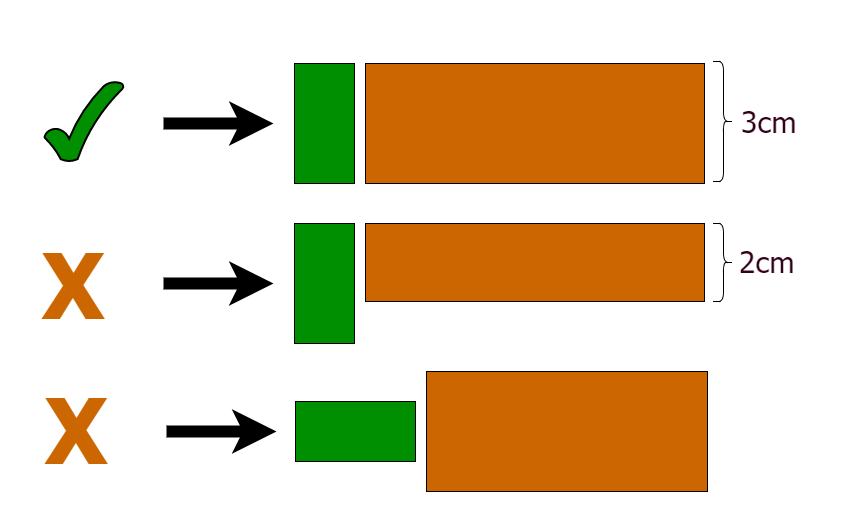 Once you are happy with your sizes, you can start to sink your holes using the electric screwdriver.
Once you are happy with your sizes, you can start to sink your holes using the electric screwdriver.
Place the longer piece in your clamp – widest side up so you can sink a hole through from top to bottom. Take your time sinking all the holes for all the longer sides (so one at each end) moving them around in the clamp if you need to.
Once you holes are all sunk – you can start your screwing.
You will be screwing the screw first through the flatter face of your longer side of wood (if it has one) and into the end of the other shorter side. Both pieces of wood need to be the same width where they meet.
So with the longer side still in the clamp with the sink hole passing from top to bottom, clamp in the shorter side end on and in line with the hole – that way both pieces of wood are held by the clamp. Then use the drill to screw in the first screw. It will first pass through the longer side – then down into the end of the shorter side. Make sure you keep it straight so it doesn’t poke out of the smaller piece of wood.
Also, make sure that the screw is totally flush or even a bit sunken into the wood on your divide – otherwise it will scratch against the glass side of your tank when in situ.
Once you have the first piece in place, do the same in the next corner, turn it in the clamp and screw in the other small side in exactly the same way.
Then up-end it and screw on the second longer piece back onto the two ends using the clamp.
After 4 corners – you have your first frame completed.
Check the size of it again if you want as it would be easier to change it now than after you have attached the mesh. If you have your tank to hand – try it for size before proceeding further.
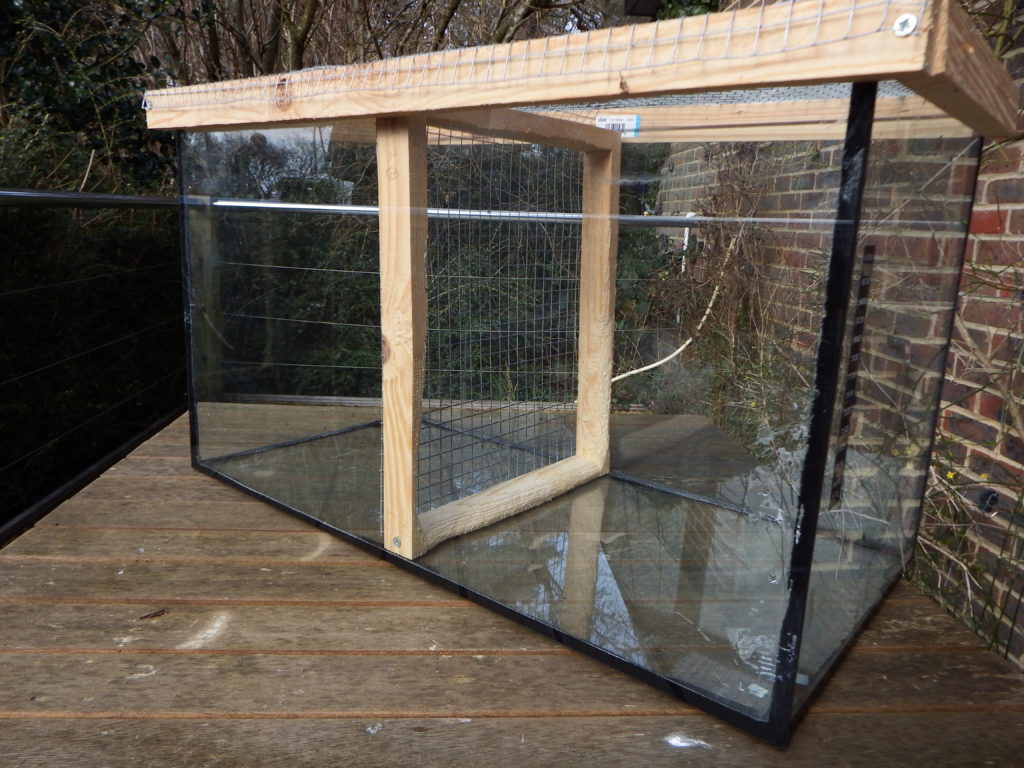
Attaching the Mesh:
Once you are happy your frame is the right size, you can cut out your mesh.
Lay your frame flat on the counter or worktop and lay the mesh over it. You are looking for hooking points.
This mesh is going to be held in place by curved nails that should go over two sides of one of the little squares of the mesh to stop it moving around. To do this you need to cut your mesh so that there are plenty of places where you can nail it down most securely.
Don’t just cut the mesh to the ‘right size’ – you almost need to aim to cut it so that it can be held in place most easily using the mesh itself as the strongest points – see below image. This might mean more cutting, but otherwise it might not be too secure or it could leave sharp edges.
Remember – if you want to leave a few inches extra mesh as a top flap for a higher lid – you need to take his into account at this point.
Make sure you leave this extra mesh the full width of the divide and coming out of the top of your divide.
Once you are happy you have cut the mesh as best you can – use the first ‘nail’ to hold one of the corners in place. Then nail to opposite corner to make sure it is square to your new frame.
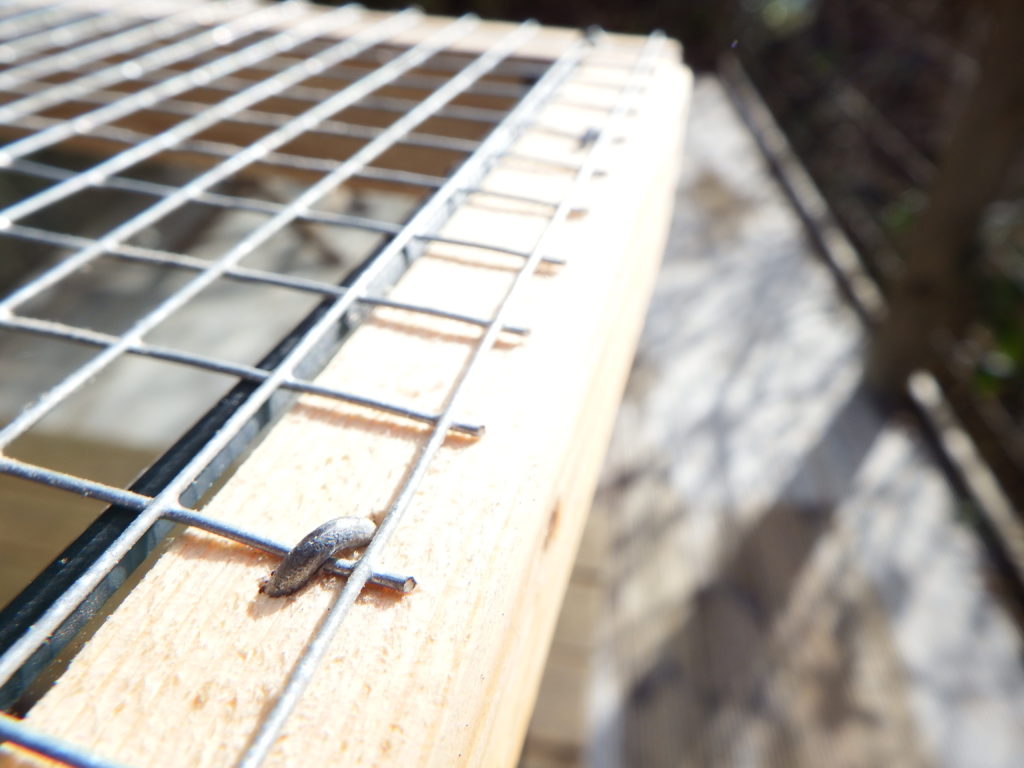
Do the other two corners to pin it down.
Then – if you are happy it is straight – run several more down each side; one at the halfway point and one at each quarterway point to hold it secure. Use more if you need to depending on the size of your divide or if you are making a larger lid.
Obviously still nail in the top of the frame but don’t use any nails in the spare flappy bit of the mesh – leave it loose.
Use the wire cutters to trim off all the excess wire outside of these nails from the sides and bottom (which can take quite a while) and make sure there are no sharp edges left anywhere.
Voila – your divide is made!
If you are making a double-wired divide – turn the frame over and repeat on the other side.
This then gives you a gap in the mesh the same width as the wood (in my case this is 2cm). This way – gerbils that are overly aggressive in the split tank can’t hurt each other so making your split tank introduction safer.
Assembling Your Split Tank
Nothing special is needed to assemble your split cage unless you want to do anything else to make sure you are happy it is secure.
Remember that your split tank divide needs to be easily removable and replaceable during the Split Tank Introduction – so it can’t be permanently attached to the tank.
You can however, put in runners or supports if you want to hold it upright – but remember that they will be sticking out into the tank when you have done the Introduction and removed the divide. Your gerbils will be living in the un-divided split tank for at least a week (or more ideally) after they have been successfully introduced – so just make sure these sticky-out bits are dangerous on their own.
I simply slide the mesh divide into the centre of the tank and then wedge a few large pieces of cardboard down the sides to make it a super tight fit.
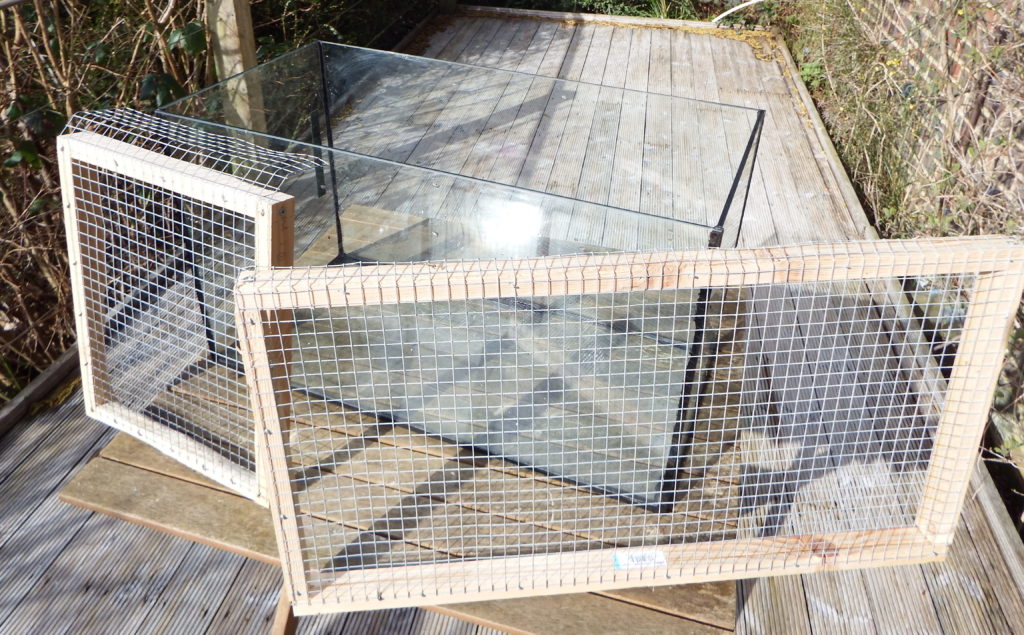
Yeah, the gerbils will chew on them – but they chew on the divide itself as well. However, you are watching them every day, really closely, and you are swapping them around three times a day – so you can make all the adjustments you need along the way.
And alternative Split Tank Set-Up would be to have the divide in the tank diagonally in the same tank. You will have to have a much larger divide overall of course – and you will need to measure the divide differently to take into account that the corner will taper into a point that your wood cannot fit into.
However, the benefit of this way of dividing the split tank is that the divide will not need wedging in and it cannot possibly fall over.
It also gives the gerbils a bit more of a surface area to interact face-to-face as well as a bit more of a running zone either side if that is what you prefer.
Using Your Split Tank
Finally, stick in some bedding, some food and a water bottle – pop in a gerbil on each side and secure the lid in place.
Done.
Your split tank introduction is now underway.
Good luck…
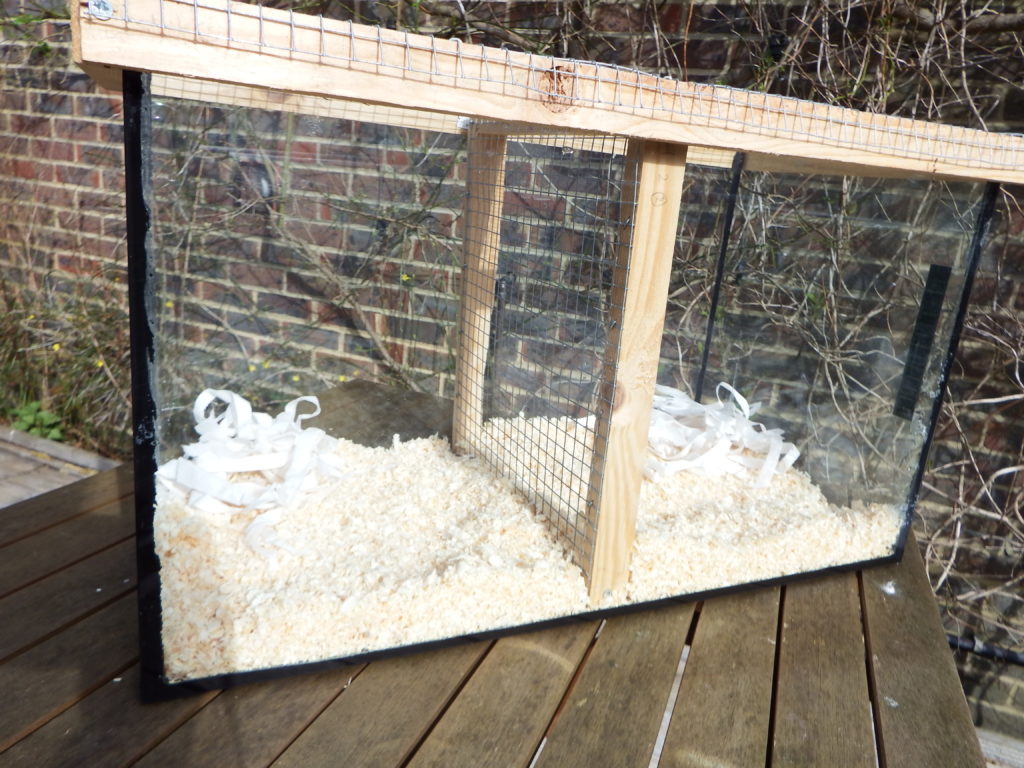
For tips on doing your Split Tank Introduction – please look at all my other articles including Split Tank Introductions and Split Tank Introductions – Top Tips before getting started; or Split Tank Intros Part 1 and Part 2 which explain all the steps involved leading up to removing the divide for the first time…